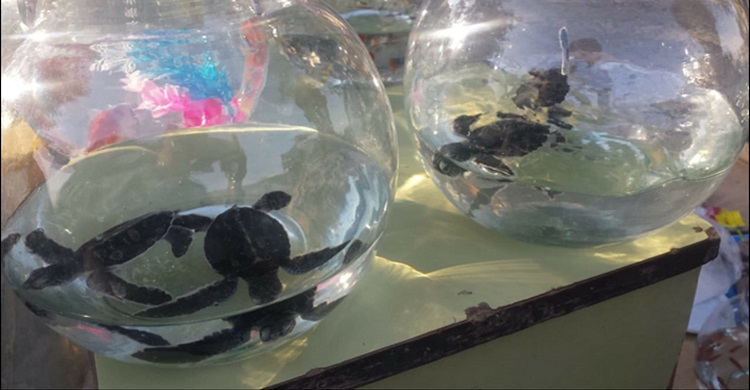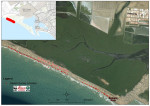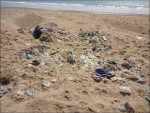Assessment of Key Threats to Marine Turtles at the Hawkse Bay Beach of Karachi and Preliminary Survey of Illegal Trade

Chelonia mydas hatchlings on display for sale in a wildlife market in Karachi © Muhammad Faisal, IMS-UoK
1Muhammad Shoaib Kiani, 1Rija Khan, Hasnain Ali, 1Muhammad Faisal, 2Humera Aisha, 1Warda Jamil, 1Iqra Mansur, 1Manal Fatima
1 Institute of Marine Science, University of Karachi-75270, Karachi; 2 WWF-Pakistan
Pakistan has a few very prominent turtle nesting beaches along its coastline including one of the globally significant twenty beaches for green turtle nesting i.e. Hawkse bay beach of Karachi coast. This beach is visited by numerous female green turtle every year. A multitude of human posed threats to nesting females and hatchlings stimulate immense concern about their future survival particularly due to absence of any long term research and locally tailored conservation initiatives. Current research was designed to assess these threats (beach surveys and monitoring) and also to carry out systematic investigation (market and online surveys) of their illegal trade. The study period was Sep. to Dec. 2019. The study beach was distributed in equal sections of 100 m each. All the threats and activities performed on the specific section were noted on data sheet. We applied the random sampling method for waste collection and visual monitoring method for other threats viz. predator(s), developmental activity and human activity. Sediment samples were also collected from high tide level at different stations by sieving, drying and density separation for occurence, abundance and characterization of microplastics. MPs are suspected to cause rise in sediment temperature which can potentially alter sex ratio of hatchlings and cause gender imbalance leading to population level implications. In addition, supporting benthic biota can be susceptible to high quantities of microplastics. Market surveys and online surveys were carried out for collection of data on illegal trade.
The results of beach surveys depicted that solid waste is present in abundance on this beach in the following ranking: plastic > organic waste > miscellaneous debris > styrofoam. Most of solid waste was recorded in the vicinity of local coastal community settlements and rental huts along the beach. Fishing nets were the most commonly featuring solid waste type. Sufficient data indicate that these cause obstruction to free movement of large female turtles on the beach and also common hatchling entanglements and mortality. Other categories of solid waste are deemed to make the beach less turtle friendly and unfit for nesting. Among predators, dogs (n=31) and kites / birds (n=14) were recorded to be the commonest. Dogs being active in early morning and evening and kites in the mornings. An occasional but drastic oil spill was also recorded. This threat has possibly long lasting and largely under-studied effects on beaches, nesting females and hatchlings locally.
Study of sediment samples for MPs highlighted that all the samples collected from three segments of Hawks bay turtle nesting beach showed frequent presence of red, blue, yellow, orange pellets and fragments with smooth and rough surfaces. No of microplastics was counted after their characterization into fragment, filaments and pellets with their colors i.e. Station A: MPs total no. 314 with 110 filaments, 80 pellets and 113 fragments / Station B: MPs 280 with 82 filaments, 91 pellets and 97 fragments and station C: total MPs 250 with 64 filaments, 92 pellets and 94 fragments. However, It was found that microplastic pollution is comparatively low as compared to studies reported from elsewhere. Further research is required to validate these findings.
Market surveys depicted that illegal turtle trade is widely rampant in wildlife markets viz. Lalu Khet, Saddar, Burns Road and Defence. Green turtle is the most commonly traded and available at low prices. However, maximum price range was recorded in the posh Defence market. Poaching is leading to the population declines of this already endangered species. Social media surveys showed that some turtles are traded online as well. Considering the compound effect of all the stressors, it is conservatively commented that this sub-population is perhaps declining. Previous evidence of abandonment of this beach by olive turtle for nesting since 2003 due to some unknown reason supports this assertion.
Regular monitoring of illegal trade channels, proper implementation of laws and beach monitoring for mitigation of key threats are recommended. Education and Awareness raising programs are proven tool in transforming negative human attitudes. Long term research particularly on assessment of their nesting performance, spatial and temporal distribution, habitat use, threats and monitoring movements through telemetry will help to generate data required for effective and efficient conservation and management policies.
Last updated on 10 December 2021





